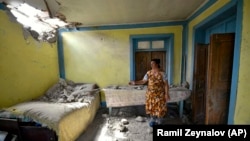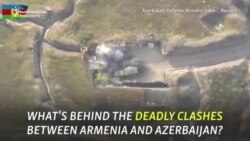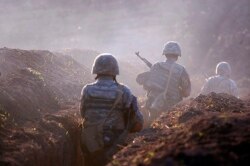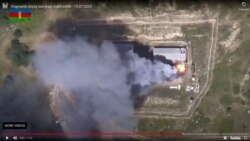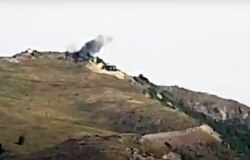Three days of fighting on the Armenian-Azerbaijani border has alarmed the international community and stoked deep national resentments in both countries.
Sixteen people in all -- most of them soldiers but including one civilian -- died in artillery and other attacks between the neighboring foes between July 12 and July 14 along a remote northern section of their border.
It is the latest in a growing history of deadly episodes that stem from a dispute over the territory of Nagorno-Karabakh.
It also is the worst episode of violence there in at least four years.
Their conflict erupted in 1988 amid ethnic Armenian demands for independence for the Nagorno-Karabakh region of Azerbaijan and unification with Armenia as Soviet authority in Moscow was collapsing.
A cease-fire agreed in 1994 ended widespread bloodshed thought to have killed around 30,000 people. But the cease-fire failed to resolve the dispute.
Hundreds of thousands of ethnic Azeris and Armenians fled both ways across the borders to join their compatriots amid fears of nationalist reprisals.
The cease-fire left Nagorno-Karabakh and areas of Azerbaijan around it under de facto Armenian control. It also set the stage for decades of deadly, but mostly minor, skirmishes along the Line of Contact and near their shared border.
Why did the violence erupt now?
In a pattern familiar from dozens of smaller skirmishes between their forces or proxies in the past two decades, each side labeled the flare-up the result of "provocations" by the other.
Some reports suggested that an Azerbaijani military vehicle traveling near a northern section of the border had helped set off the initial incident on July 12.
But independent confirmation in such cases has proven nearly impossible.
"It's strange because it wasn't really provoked by anything," Arkady Dubnov, a political analyst at the Carnegie Moscow Center told Current Time, the Russian-language network led by RFE/RL in cooperation with VOA.
He said there did not appear to be any "inherent explanation" for the sudden burst of violence other than possible nationalist efforts to portray any confrontation as some sort of "victory" in the standoff.
"All the circumstances connected to the occurrence of this conflict suggest the [major] factor was human in nature, and not military-political, strategic, or geopolitical,” Dubnov said.
Thomas de Waal, a senior fellow at Carnegie Europe, acknowledged the familiar finger-pointing and lack of clarity but argued that interruptions in the nearly three-decade-old cease-fire between Armenia and Azerbaijan are "a political decision."
"Nothing accidental here. Cease-fire violations are a political decision," de Waal tweeted.
He also suggested that Baku might have been more frustrated at the current impasse -- despite international mediators' encouragement early last year that the leaders of Armenia and Azerbaijan should "prepare their populations for peace."
"It is unclear who started it, though [Azerbaijan] has greater interest in doing so, as it likes to remind the world that the situation on the ground is 'not normal,' is frustrated with lack of political progress since 2018. [Azerbaijani President Ilham] Aliyev said this openly on July 7," de Waal tweeted.
Last week, Aliyev threatened to withdraw from the stalled international peace negotiations "if they yield no results."
Is this fighting unusual in its intensity or any other facet?
The combined death toll -- 15 troops and one civilian -- represents the highest number of fatalities in Armenian-Azerbaijani fighting since 2016. Before that, the most recent comparable flare-up was in 2008.
It was unusual also in that an Azerbaijani major general was reportedly killed on the third day of fighting, on July 14.
Most of the skirmishes during the past three decades involved sniper or machine-gun fire and far more limited casualty figures -- usually lower-ranking troops and sometimes civilians.
This time, the fighting appeared to involve tanks, drones, artillery, and mortars.
This fighting was also unusual in that it reportedly broke out far away from the disputed territory of Nagorno-Karabakh, on the internationally recognized border between Armenia and Azerbaijan.
And reports suggest it had been limited to a smaller area than some of the biggest clashes of the past decade.
Olesya Vartanian, a senior analyst for the International Crisis Group and a former RFE/RL correspondent, cautioned against facile comparisons to the so-called Four-Day War of 2016 that killed more than 200 people in the worst fighting since the 1994 cease-fire.
"Some reporters rush with comparisons to the 2016 escalation," Vartanyan tweeted. "This is a mistake. Because this flareup is currently in a small area with only a limited number of heavy weaponry involved. In 2016 the clashes were along the whole frontline in the Nagorno-#Karabakh conflict zone."
How does domestic politics currently fit into the equation?
Like clockwork, the bursts of violence whipped up nationalist frenzy in both countries.
"If part of the military-political wing of either side wants to show that he is a great patriot and defender of the interests of the homeland, then he can aggravate [the situation]," Dubnov told Current Time. "This is very dangerous."
In Baku on July 14, the public anger over the deaths of Azerbaijani troops brought thousands of people out into the streets, despite coronavirus restrictions on gatherings, and threatened to tumble out of control.
Police and security forces clashed with the crowds and reported dozens of arrests after some of the demonstrators -- chanting nationalist phrases like "Mobilization!" and "Azerbaijan is indivisible!" in reference to Nagorno-Karabakh -- stormed the Azerbaijani parliament building.
The public demonstrations eased overnight.
In Yerevan, Armenian Prime Minister Nikol Pashinian pledged that Azerbaijani actions would "not go unanswered."
Violence along the line of contact agreed in the 1994 cease-fire over Nagorno-Karabakhh had declined since Pashinian took power two years ago in a bloodless revolt fueled by street protests over perceived corruption and political stagnation.
That lull had initially been accompanied by increased diplomatic and political talks and greater military communication between the two sides before the recent flare-up.
But bilateral tensions had been rising for at least the last year.
Facing mounting domestic political attacks and public impatience at the speed of reforms, Pashinian dealt a blow to peace efforts a year ago by declaring defiantly to a crowd in the Nagorno-Karabakh capital that "Artsakh is Armenia."
"[A]s soon as one side starts, the other responds, neither backs down," de Waal said of this week's violence. "The conflict sits deep in both nations. We see a Rallying Round the Flag in both countries. That's useful to both govts, distracts people from economic woes and pandemic."
Outside observers like the Crisis Group have argued that "without talks on key issues -- the future of areas adjacent to Nagorno-Karabakh and people currently residing there, prospects for international peacekeeping, and Nagorno-Karabakh’s status – positions risk hardening further."
Are there indications that this is a renewal of large-scale conflict rather than the familiar pattern of skirmishes in a long-simmering "frozen conflict"?
Defense officials in both countries announced on July 15 that there had been no new fighting overnight, providing hope that the violence will not spiral out of control despite a hardening of rhetoric.
The fresh bloodshed comes against a backdrop of a UN push for the "cessation of hostilities in all situations" as governments around the world focus on fighting the coronavirus pandemic.
The United States, the European Union, Turkey, and Russia have all urged restraint from Baku and Yerevan.
Turkey, the first state to recognize Azerbaijan’s independence in 1991, has remained a staunch strategic ally of that majority-Muslim, largely Turkic-speaking country and a historical foe of Yerevan.
Turkish President Recep Tayyip Erdogan signaled his frustration at the absence of international mediation efforts over Nagorno-Karabakh in his 2019 speech to the UN General Assembly.
Erdogan warned that stability in the South Caucasus was "very important for the fair and peaceful future of our world."
Russia has, meanwhile, maintained deep economic, military, and strategic ties with Armenia, although there seems to have been a diplomatic cooling since Armenian Prime Minister Pashinian took power two years ago.
But Moscow wields some influence in Azerbaijan, too.
Russian Foreign Minister Sergei Lavrov reportedly spoke to his counterparts in both countries on July 13 and urged them to "show restraint" to avoid further destabilizing the region.
On July 14, Russian President Vladimir Putin's spokesman said Moscow was ready to mediate if called upon.
The European Union urged both countries to "stop the armed confrontation" and "undertake immediate measures to prevent further escalation," according to AFP.
And U.S. Secretary of State Mike Pompeo on July 15 said the United States was "deeply concerned" about the Armenian-Azerbaijani violence. He urged all sides to "de-escalate."
The OSCE Minsk Group -- co-chaired by the United States, Russia, and France -- has existed since 1992 to encourage a framework for lasting peace and security between Armenia and Azerbaijan.
But it has seemingly eased its activities in recent years in favor of more bilateral contacts between Baku and Yerevan.
It hasn't convened a summit bringing together the Armenian and Azerbaijani heads of state since 2017.
De Waal warned late in 2019 that "if the situation deteriorates once again, it will be a test for the international mediators of the OSCE Minsk Group from France, Russia, and the United States, which have been extremely quiet about Nagorno-Karabakh for the past two years, letting Armenia and Azerbaijan take the lead. But they may have no choice but to be more active and push for new ideas and new approaches, to stop this smoldering conflict from igniting again."




